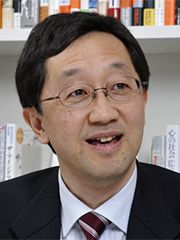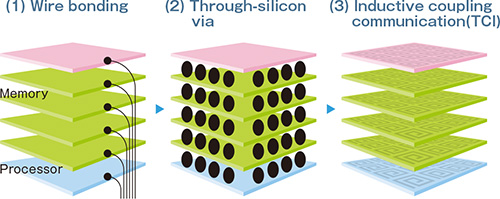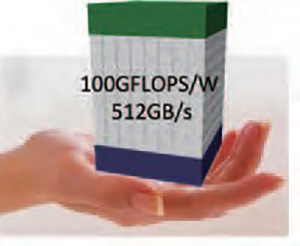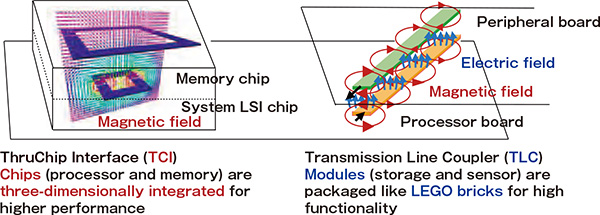Research Results
3D chip with wireless data link
Ultra low-power consumption high-speed data transmission! FY2017

- Tadahiro Kuroda (Professor, Science and Technology, Keio University)
- CREST
- echnology Innovation and Integration for Information Systems with Ultra Low Power
"Generation of High-performance, Ultra-low-power, Short-range Wireless Mobile Information System" Research Director (2005-2011) - CREST
- Fundamental Technologies for Dependable VLSI System "Dependable Wireless Solid-State Drive (SSD)" Lead Joint Researcher (2009-2015)
- ACCEL
- "Realization and development of innovative information processing system and application using near-field coupling integration technology" Research Director (2015 - 2020)
Data communication at low power consumption but at high speed
Since technologies advanced and computer processing power increased, vast amounts of data are now being exchanged. The higher the volume of data to be processed becomes, the more difficult the operation will be due to higher consumption power and heat generation. In recent years, the research has therefore been pursued to dramatically reduce power consumption, which attracts enormous attention. In order to catch up with the accelerating evolution of the information society, reduction of power consumption is definitely needed.
Ahead of any other teams in CREST, the team led by Professor Tadahiro Kuroda has successfully reduced the consumption power straight to 1/1000 of the conventional level thanks to the short-range wireless data communication technology. That is the ThruChip Interface (TCI), which is one of the chip-to-chip wireless communication technologies utilizing near-field coupling (method of wireless communication for very short range using coils).
Specifically saying with concrete figures, the data of 6 million two-hour movies can be transmitted from chip to chip by only little electric power out of one button battery, which the amount of data is equivalent to a record of 1400 years of time. This is the epoch-making technology and the highly potential research to open up a new step, which the Professor Kuroda's team only could accomplish through long-time researches on lower power consumption and wireless communication.
ThruChip Interface actually reduced the electric power to 1/1000
TCI is the technology that can reduce the consumption power to 1/1000. Then, how can TCI be described? To put it simply, this technology realizes wireless data communication from chip to chip stacked within a large-scale integrated circuit. The research on 3D implementation that pursues higher speed communication by stacking chips, not by laying chips on a flat surface, has been being conducted worldwide. However, there were major problems of low processing speed due to the wire bonding technology for connecting chip to chip, high manufacturing cost due to through-silicon via that drills a vertical hole to make a path for signal, and so on. (See Figure)
ThruChip Interface =TCI is the technology that can solve these problems by wirelessly connecting chip to chip using a circuit technology, instead of drilling a hole that penetrates chips. Coils are made using a wiring on a chip. As a current flowing along the coil on one side is changed, the magnetic field running between the coils changes accordingly, which results in a voltage change in the other coil and then in data transmission. What is happening in this technology is quite simple - non-contact data communication between two coils as mentioned above. It is simple but absolutely unique in terms of the idea of using magnetic field coupling for inter-chip data transfer.
Evolution of the communication technology for stacked chips

Unique development of non-contact connector applicable also to smartphones
Speaking of the technologies uniquely developed b y Professor Kuroda and his collaborators, Transmission Line Coupler (TLC) - the non-contact connector technology using electromagnetic field coupling - is also important. Normally, connector is to mechanically connect circuit boards and modules. On the other hand, this non-contact connector is wireless t ype so that it hardly undergoes communication failures due to loose connection as compared to the conventional connectors that are to be mechanically connected, while it contributes to cost reduction due to lighter weight and is applicable to high-speed, power-saving and reliable systems. In the most recent release, the non-contact connector became even smaller and the applicability to connections between small modules, such as smartphones, was verified.
Toward the realization of small, high performance, low power consumption and high reliability system
In 2015, Professor Kuroda and his collaborators have star ted the research and development for ACCEL toward the realization of the even lower power consumption and higher performance information processing integrated system. In this research and development, system LSI (Large Scale Integration) and memory LSI are three- dimensionally stacked using TCI, and in order to wirelessly connect peripheral modules, such as sensors, using TLC. This research will also definitely gather worldwide attention. And the Professor Kuroda's unique TCI and TLC technologies will be utilized to realize small, high performance and highly reliable 3 D chips, applied to systems requiring high speed and high reliability, and, as a core technology for semiconductor-applied products, applied to artificial intelligence, such as for data center, robot, machine learning and deep learning, and will contribute to the evolution of the information and communication technologies, such as for intelligent terminal, high performance small computer and next generation super computer that are made to process information at even higher speed.
Vision the Team Kuroda aims for

Data-centric computer
(Super low power consumption mobile computer for the IoT age)

Near-field coupling integration technology (Solution for connection problem in large-scale systems)
